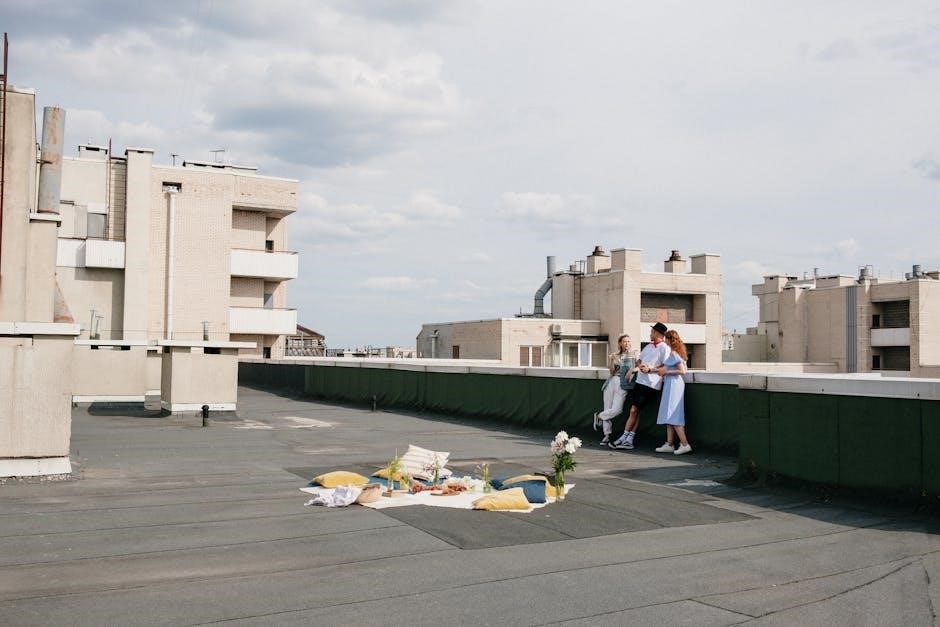Claudia Rankine’s Citizen: An American Lyric is a groundbreaking work that blends poetry, essays, and visual art to explore race, identity, and citizenship in America.
First published in 2014, the book has become a landmark of contemporary literature, offering a searing examination of systemic racism and microaggressions through personal and collective experiences.
Rankine’s innovative style challenges traditional forms, creating a powerful narrative that resonates deeply with readers, making it one of the most influential works of the 21st century.
Overview of the Book and Its Significance
Citizen: An American Lyric is a provocative exploration of race, identity, and citizenship in modern America. Blending poetry, essays, and visual imagery, the book examines systemic racism and microaggressions through personal and collective experiences. Its innovative structure challenges traditional literary forms, creating a powerful narrative that resonates deeply with readers. Ranked among the most influential works of the 21st century, Citizen has received widespread critical acclaim and was nominated for the National Book Critics Circle Award in both Poetry and Criticism, solidifying its significance in contemporary literature.
Historical and Cultural Context
Citizen: An American Lyric reflects the deep-rooted racial tensions and historical injustices in America, offering a modern perspective on the legacy of discrimination and inequality.
The Tradition of American Lyric Poetry and Race
Claudia Rankine’s Citizen: An American Lyric reimagines the tradition of American lyric poetry by centering race and identity, challenging the genre’s historical dominance by white voices.
Rankine’s use of the second-person narrative creates a collective experience, bridging personal and societal realms. Her work echoes earlier poets like Langston Hughes, who also explored racial injustice, while innovating through hybrid forms and visual elements.

By addressing systemic racism and microaggressions, Rankine expands the lyric tradition, making it a powerful tool for contemporary social critique and fostering a broader conversation about citizenship and belonging.

Structure and Style of Citizen
Claudia Rankine’s Citizen uniquely blends poetry, essays, and visual imagery, creating a hybrid form that mirrors the fragmented nature of racial experiences in America.
The book’s structure reflects the fluidity of identity, employing prose, verse, and art to convey the complexities of systemic racism and personal narratives.
This innovative style challenges traditional literary boundaries, offering a multifaceted exploration of citizenship and race.
Blending Poetry, Essay, and Visual Imagery
Claudia Rankine’s Citizen masterfully combines poetry, essays, and visual art to create a layered, immersive exploration of race and identity. The interplay of these forms allows for a dynamic narrative that shifts seamlessly between personal reflection and broader societal critique. Poetry provides emotional depth, while essays offer analytical rigor, and visuals disrupt and enhance the text, creating a multisensory experience. This hybrid approach challenges traditional literary boundaries, reflecting the fragmented nature of racial experiences and amplifying the book’s emotional and intellectual impact.
The Use of Second-Person Narrative in Exploring Race
Claudia Rankine employs the second-person narrative in Citizen to create an intimate and universal experience, drawing readers into the protagonist’s journey. The use of “you” blurs the line between individual and collective experience, making racial encounters feel both personal and shared. This narrative choice challenges readers to confront their own complicity in systemic racism, fostering empathy and self-reflection. By addressing the reader directly, Rankine transforms the text into a powerful tool for exploring the complexities of racial identity and societal expectations, making the narrative both deeply personal and broadly relatable.
Central Themes and Ideas
Claudia Rankine’s Citizen examines systemic racism, microaggressions, and the invisibility of Black identity, exploring their emotional toll and psychological impact on Black individuals in America.
Systemic Racism and Microaggressions
Claudia Rankine’s Citizen delves into the pervasive nature of systemic racism and the subtle, cumulative impact of microaggressions on Black individuals. These everyday slights, often dismissed as insignificant, are revealed as deeply wounding, perpetuating feelings of invisibility and alienation. Rankine illustrates how such encounters, whether verbal or silent, reinforce racial hierarchies and erode a sense of belonging. By exploring these experiences, she exposes the insidious ways racism is embedded in American culture, challenging readers to confront their own complicity in these systems.
Invisibility and Erasure of Black Identity
Claudia Rankine’s Citizen vividly portrays the pervasive invisibility and erasure of Black identity in American society. Through lyrical prose and haunting imagery, she captures the ways systemic racism renders Black individuals unseen and unheard. This erasure is not merely physical but existential, denying Black people their full humanity. Rankine illustrates how even in mundane interactions, Black bodies are reduced to stereotypes or overlooked entirely. The emotional toll of this invisibility is profound, leaving individuals questioning their place and validity in a society that repeatedly marginalizes them.

Key Poems and Essays in Citizen
Citizen features pivotal poems and essays that explore race, identity, and societal interactions. These works seamlessly blend personal narratives with cultural critiques, creating a profound emotional resonance.
Analysis of Specific Poems and Their Emotional Resonance
Claudia Rankine’s poems in Citizen are deeply personal and politically charged, evoking a visceral response through their exploration of race and identity. Poems like “You are in the dark, in the car…” vividly capture moments of racial tension, while others, such as those reflecting on childhood experiences, highlight the enduring impact of systemic racism. The use of the second-person narrative creates intimacy, drawing readers into the protagonist’s struggles. These poems resonate emotionally, offering a haunting yet necessary reflection of America’s racial landscape, making them unforgettable and impactful.
Essays on Citizenship and Racial Justice
Claudia Rankine’s essays in Citizen are a masterful blend of personal narrative, cultural critique, and lyrical prose, probing the complexities of citizenship and racial justice. Through vivid vignettes and incisive analysis, she examines how systemic racism erodes black identity and belonging. Essays like “Making Room” and “The Condition of Black Life” challenge societal norms, urging readers to confront their complicity in racial inequities. Rankine’s work is both a call to action and a deeply human exploration of what it means to be seen—and unseen—in America.
The Protagonist’s Journey
The protagonist in Citizen navigates a life marked by early exposure to racism, tracing a journey from childhood innocence to the stark realities of adulthood, conveying the enduring impact of systemic discrimination.
From Childhood to Adulthood: Experiencing Racism
The protagonist in Citizen experiences racism from an early age, encountering moments of racial awareness that shape their understanding of identity and belonging. As a child, they face subtle yet profound inequalities, such as being overlooked or dismissed, which escalate into more overt acts of discrimination in adulthood. Rankine vividly captures the accumulation of these experiences, illustrating how systemic racism permeates everyday life. The protagonist’s journey reflects the resilience required to navigate a society that often renders Black individuals invisible or hyper-visible, depending on the context.

The Psychological Toll of Racial Discrimination
In Citizen, the protagonist grapples with the internalized trauma of racial discrimination, which manifests as a constant sense of hypervigilance and emotional exhaustion. The accumulation of microaggressions and overt racism creates a weight that is both deeply personal and universally relatable. Rankine illustrates how these experiences erode a sense of safety and belonging, forcing the protagonist to navigate a world where their identity is continually questioned. This psychological burden highlights the profound impact of systemic racism on mental health and the resilience required to survive it. The text underscores the silent, enduring pain of living in a society that often refuses to see or hear Black individuals.

Imagery and Symbolism
Citizen employs vivid imagery and symbolism to convey racial tensions, blending poetry with visual art to explore invisible barriers and systemic racism, creating a powerful narrative of identity and oppression.

The Role of Visual Art in Conveying Racial Tensions
Claudia Rankine’s Citizen integrates visual art to amplify its exploration of racial tensions, using images as a medium to depict the invisible yet pervasive experiences of racism. The visuals, often juxtaposed with text, create a layered narrative that challenges readers to confront the intersections of race, identity, and societal expectations. This fusion of art and prose not only enhances the emotional impact but also provides a unique lens through which to view the complexities of racial dynamics in America. The imagery becomes a silent yet powerful companion to the written word, underscoring the theme of invisibility and erasure faced by Black individuals in a society that often overlooks their struggles. By incorporating these visual elements, Rankine invites readers to engage with the text on multiple levels, fostering a deeper understanding of the systemic and personal ramifications of racism. The interplay between visual and textual storytelling in Citizen is a testament to the power of interdisciplinary art in addressing social justice issues, making the work a pivotal contribution to contemporary discussions on race and identity.
Symbolism in Exploring Invisible Barriers
Claudia Rankine uses powerful symbolism in Citizen to expose the invisible barriers faced by Black individuals in America. Everyday objects and scenarios—such as a white girl’s gesture in class or the color of a shirt—become charged with racial significance, highlighting the pervasive yet unspoken nature of racism. These symbols reflect the psychological toll of living in a society where Black identity is constantly questioned and erased. Rankine’s use of the second-person narrative intensifies the immediacy of these symbols, making the reader complicit in the exploration of racial invisibility and its profound emotional impact.

Reception and Legacy
Claudia Rankine’s Citizen received widespread acclaim, earning nominations for the National Book Critics Circle Award in Poetry and Criticism. Rankine’s work has redefined contemporary poetry, influencing future writers to address race and identity with unflinching honesty. Her innovative style and fearless exploration of systemic racism have solidified her legacy as a leading voice in American literature. The book remains a pivotal text in discussions of racial justice and citizenship, inspiring new generations of writers and thinkers.
Awards and Critical Acclaim
Claudia Rankine’s Citizen: An American Lyric earned widespread recognition, including a National Book Critics Circle Award nomination in both Poetry and Criticism, winning in Criticism. The book was praised for its innovative blend of poetry, essay, and visual art, addressing systemic racism and microaggressions with unflinching honesty. Critics lauded its fearless exploration of race and identity, solidifying its place as a landmark work in contemporary literature. Rankine’s work has been celebrated for its profound impact on discussions of citizenship and racial justice.
Claudia Rankine’s Citizen: An American Lyric masterfully blends poetry, essays, and visuals to explore race and citizenship. Its profound impact continues to inspire future writers and conversations on racial justice.
Claudia Rankine’s Influence on Future Generations of Writers

Claudia Rankine’s Citizen: An American Lyric has left an indelible mark on contemporary literature, inspiring a new generation of writers to explore race, identity, and citizenship with unflinching honesty. Its innovative blend of poetry, essay, and visual art has redefined the boundaries of literary expression, encouraging others to experiment with interdisciplinary forms. Rankine’s work has become a blueprint for addressing systemic racism and microaggressions, empowering writers to confront uncomfortable truths and challenge societal norms. Her influence ensures that conversations about racial justice and identity will continue to evolve in meaningful ways.
